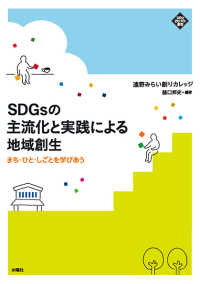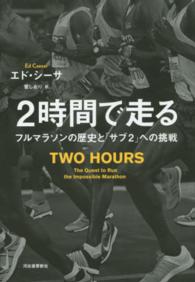- ホーム
- > 洋書
- > ドイツ書
- > Social Sciences, Jurisprudence & Economy
- > Education Science / Pedagogic
- > adult education
Full Description
This book examines the push and pull of factors contributing to and constraining conversion of STEM (science, technology, engineering and math) education programs into STEAM (science, technology, engineering, math and arts) education programs. The chapters in this book offer thought-provoking examples, theory, and suggestions about the advantages, methods and challenges involved in making STEM to STEAM conversions, at levels ranging from K12 through graduate university programs. A large driving force for STEM-to-STEAM conversions is the emerging awareness that the scientific workforce finds itself less than ideally prepared when engaging with so-called 'wicked problems' - the complex suite of emerging, multifaceted issues such as global climate change, social injustice, and pandemic diseases. Dealing with these issues requires cross-disciplinary expertise and the ability to insert technical and scientific understanding effectively into areas of public planning and policy.
The different models and possibilities for STEAM, as the next phase of the STEM revolution, laid out in this book will promote research and further our understanding of STEAM as a forward-thinking approach to education.
Gillian Roehrig, STEM Education, University of Minnesota, USA
The ideal teacher sees opportunities for integrating ideas from multiple disciplines into every lesson. This book offers many worthwhile suggestions on how to do that deliberately and systematically
George DeBoer, Project 2061 of the American Association for the Advancement of Science, USA
For the last several years, calls for expanding STEM education have grown, but so too have concerns about technocratic approaches to STEM. This volume challenges the community to consider broader views on STEM by focusing on the place of arts education within this movement. The chapters offer much needed, new perspectives on the (re)integration of the arts and sciences
Troy Sadler, School of Education, University of North Carolina, USA
Contents
1 Prologue; Arthur J. Stewart, Michael P. Mueller and Deborah J. Tippins.- 2 From STEM to STEAM: How Can Educators Meet the Challenge? Mariale M. Hardiman and Ranjini M. JohnBull.- 3 The Importance of Integrating the Arts into STEM Curriculum; Michelle Land.- 4 Purposeful Pursuits: Leveraging the Epistemic Practices of the Arts and Sciences; Bronwyn Bevan, Kylie Peppler, and, Lynn Scarff.- 5 Investigating the Complexity of Developing STEAM Curricula for Middle School Students; Danielle Herro, and Cassie Quigley.- 6 We Need More (than) STEAM: Let's go for Life-wide and Lifelong Education; Wolff-Michael Roth.- 7 Using Project-Based Learning to Teach STEAM; Gary Ubben.- 8 How to Structure Project-Based Learning to meet STEAM Objectives; Gary Ubben.- 9 Enhancing STEAM Education through Cultivating Students' Savoring Capacity; Shu-Hsuan Chang, Li-Chih Yu, Jing-Chuan Lee, and Chih-Lien Wang.- 10 Science, Youth and Integration—The Quest for Mindfulness through Birding; Erin A. Ingle andMike Mueller.- 11 The Role of STEAM in a Sustainable World; Shushman Choudhury, Sohn Cook, and Brittany Bennett.- 12 Transgressing the Disciplines using Science as a Meeting place: The Science, Art and Writing Initiative; Anne Osbourn.- 13 Artistic Ways of Knowing: Ensuring Substantive Arts Involvement in the STEM/STEAM Classroom; Joanne Haroutounian.- 14 Putting the STEAM in the River: Science, Technology, Engineering, Arts, and Mathematics and their Potential Transformative Roles in School District Culture, Organization, Systems, and Learning Environments; John Puglisi, and Elizabeth Yeager.- 15 Emerging Scenarios to Enhance Creativity in Smart Cities through STEAM Education and the Gradual Immersion Method; Jorge Sanabria, and Margarida Romero.- 16 Applying Gradual Immersion Method to Chemistry: Identification of Chemical Bonds; Guillermo Pech, Jorge Sanabria, and Margarida Romero.- 17 From Conceptualization to Implementation: STEAM Education in Korea; Sophia (Sun Kyung) Jeong, Hyoungbum Kim, and Deborah Tippins.- 18 Emphasizing Transdisciplinary Prowess in the Evaluation of STEAM Programs; Kimberle Kelly, and Erin M. Burr,- 19 STEM Education and the Theft of Futures of our Youth: Some Questions and Challenges for Educators; Sophia (Sun Kyung) Jeong, Deborah J. Tippins, Kimberly Haverkos, Mel Kutner, Shakhnoza Kayumova, and Stacey Britton.







